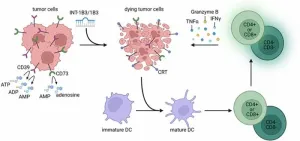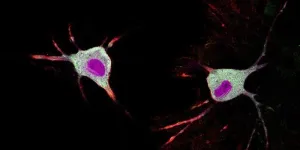(Press-News.org) Pneumonia diagnoses are marked by pronounced uncertainty, an AI-based analysis of over 2 million hospital visits has found.
More than half the time, a pneumonia diagnosis made in the hospital will change from a patient’s entrance to their discharge—either because someone who was initially diagnosed with pneumonia ended up with a different final diagnosis, or because a final diagnosis of pneumonia was missed when a patient entered the hospital (not including cases of hospital-acquired pneumonia).
The study describing the new results publishes August 6th in Annals of Internal Medicine.
Barbara Jones, MD, MSCI, pulmonary and critical care physician at University of Utah Health and the first author on the study, found the results by searching medical records from more than 100 VA medical centers across the country, using artificial intelligence-based tools to identify mismatches between initial diagnoses and diagnoses upon discharge from the hospital. More than ten percent of all such visits involved a pneumonia diagnosis, either when a patient entered the hospital, when they left, or both.
“Pneumonia can seem like a clear-cut diagnosis,” Jones says, “but there is actually quite a bit of overlap with other diagnoses that can mimic pneumonia.” A third of patients who were ultimately diagnosed with pneumonia did not receive a pneumonia diagnosis when they entered the hospital. And almost 40% of initial pneumonia diagnoses were later revised.
The study also found that this uncertainty was often evident in doctors’ notes on patient visits; clinical notes on pneumonia diagnoses in the emergency department expressed uncertainty more than half the time (58%), and notes on diagnosis at discharge expressed uncertainty almost half the time (48%). Simultaneous treatments for multiple potential diagnoses were also common.
When the initial diagnosis was pneumonia, but the discharge diagnosis was different, patients tended to receive a greater number of treatments in the hospital, but didn’t do worse than other patients as a general rule. However, patients who initially lacked a pneumonia diagnosis, but ultimately ended up diagnosed with pneumonia, had worse health outcomes than other patients.
The new results call into question much of the existing research on pneumonia treatment, which tends to assume that initial and discharge diagnoses will be the same. Jones adds that doctors and patients should keep this high level of uncertainty in mind after an initial pneumonia diagnosis and be willing to adapt to new information throughout the treatment process. “Both patients and clinicians need to pay attention to their recovery and question the diagnosis if they don’t get better with treatment.”
###
The study publishes in the August 6th issue of Annals of Internal Medicine as "Diagnostic Discordance, Uncertainty, and Treatment Ambiguity in Community-Acquired Pneumonia: A National Cohort Study of 115 U.S. Veterans Affairs Hospitals."
END
Hospital pneumonia diagnoses are uncertain, revised more than half the time, study finds
2024-08-05
ELSE PRESS RELEASES FROM THIS DATE:
Cancer screening estimated to cost $43 billion a year in the United States
2024-08-05
Embargoed for release until 5:00 p.m. ET on Monday 5 August 2024
Annals of Internal Medicine Tip Sheet
@Annalsofim
Below please find summaries of new articles that will be published in the next issue of Annals of Internal Medicine. The summaries are not intended to substitute for the full articles as a source of information. This information is under strict embargo and by taking it into possession, media representatives are committing to the terms of the embargo not only on their own behalf, but also on behalf of the organization they represent.
----------------------------
1. ...
Researchers receive 9.5 million grant to study relationship between polyphenol intake, Alzheimer’s prevention, and the brain-gut-microbiome system
2024-08-05
UCLA Health researchers, in collaboration with researchers from the Republic of Ireland and Northern Ireland, have received $9.5 million award from the National Institutes of Health (NIH) with support from European funding agencies — The Science Foundation Ireland (SFI) and the Public Health Agency Health & Social Care (HSC) — to study the effects of polyphenols on cognitive health and the brain-gut microbiome system.
The proposal, named MAEVE, stands for “Microbiota mediated flavonoid metabolites for cognitive health.”
In this interdisciplinary and multicenter study funded through the Tripartite US-Ireland Research & Development Partnership Program, ...
UH astronomers uncover risks to planets that could host life
2024-08-05
A groundbreaking study has revealed that red dwarf stars can produce stellar flares that carry far-ultraviolet (far-UV) radiation levels much higher than previously believed. This discovery suggests that the intense UV radiation from these flares could significantly impact whether planets around red dwarf stars can be habitable. Led by current and former astronomers from the University of Hawaiʻi Institute for Astronomy (IfA), the research was recently published in the Monthly Notices of the Royal Astronomical Society.
“Few stars have been thought to generate ...
An overlooked side-effect of the housing crisis may be putting Californians at increased risk from climate disasters
2024-08-05
In a new article for the journal Proceedings of the National Academy of Sciences, UC Santa Cruz researchers laid out the foundation for their highly-anticipated upcoming study of how lack of affordable housing in urban areas of California may be driving increased development in and near wildlands, leading to more severe climate change impacts.
Since the 1990s, California has led the nation in the growth of Wildland-Urban Interface (WUI) development, with more than one in three households in the state now located immediately next to or within ...
INT-1B3 miR-193a-3p mimic boosts t cell immunity and induces tumor cell death
2024-08-05
BUFFALO, NY- August 5, 2024 – A new research paper was published in Oncotarget's Volume 15 on July 12, 2024, entitled, “INT-1B3, an LNP formulated miR-193a-3p mimic, promotes anti-tumor immunity by enhancing T cell mediated immune responses via modulation of the tumor microenvironment and induction of immunogenic cell death.”
In this study, researchers Chantal L. Duurland, Thijs de Gunst, Harm C. den Boer, Marion T.J. van den Bosch, Bryony J. Telford, Rogier M. Vos, Xiaolei Xie, Mingfa Zang, Fang Wang, Yingying Shao, Xiaoyu ...
Wayne State University professor receives NSF grant to study quantum tunneling
2024-08-05
DETROIT — A Wayne State University professor recently received a three-year, $626,467 grant from the National Science Foundation’s Division of Physics. The project, “Probing Nonadiabatic Strong Field Ionization with Phase-Resolved Attoclock,” will research a quantum mechanical process known as quantum tunneling.
Wen Li, Ph.D., professor of chemistry in Wayne State’s College of Liberal Arts and Sciences and his research team propose a new technique they have developed to study the process of quantum tunneling, a quantum mechanical phenomenon in which an object such as an electron or atom passes through ...
Adding metastasis-directed radiation therapy boosts progression-free survival in metastatic pancreatic cancer
2024-08-05
Researchers from The University of Texas MD Anderson Cancer Center demonstrated that adding metastasis-directed radiation therapy to standard-of-care chemotherapy improved progression-free survival (PFS) in patients with oligometastatic pancreatic cancer. Findings from the multicenter EXTEND trial, published today in the Journal of Clinical Oncology, were first presented at the 2024 American Society of Clinical Oncology (ASCO) Gastrointestinal Cancers Symposium.
At a median follow-up of 17.3 months, PFS was 10.3 months in patients who received metastasis-directed therapy (MDT) ...
New method tracks how psychedelics affect neurons in minutes
2024-08-05
Researchers at the University of California, Davis have developed a rapid, noninvasive tool to track the neurons and biomolecules activated in the brain by psychedelic drugs. The protein-based tool, which is called Ca2+-activated Split-TurboID, or CaST, is described in research published in Nature Methods.
There has been mounting interest in the value of psychedelic-inspired compounds as treatments for brain disorders including depression, post-traumatic stress disorder and substance use disorder. Psychedelic ...
Record number of drug overdoses in one year reported
2024-08-05
August 4, 2024-- Drug-involved overdose deaths increased by over 500 percent in 2022 according to a study at Columbia University Mailman School of Public Health, with trends attributed to synthetic opioids. National data shows that fentanyl and heroin in particular attributed substantially to the rise particularly since 2014. However, the study also reports that income protection policies, can have a supportive role in preventing fatal drug overdoses. The findings are reported in the International ...
Could this new drug turn back the clock on multiple sclerosis?
2024-08-05
Could This New Drug Turn Back the Clock on Multiple Sclerosis?
Ten years of work, and a little help from the green mamba snake, has resulted in a promising new drug that is already being tested in clinical trials.
Multiple sclerosis (MS) degrades the protective insulation around nerve cells, leaving their axons, which carry electrical impulses, exposed like bare wires. This can cause devastating problems with movement, balance and vision; and without treatment, it can lead to paralysis, loss of independence and a shortened lifespan.
Now, scientists at UC San Francisco and Contineum Therapeutics have developed a drug that spurs the body to replace the lost insulation, ...



